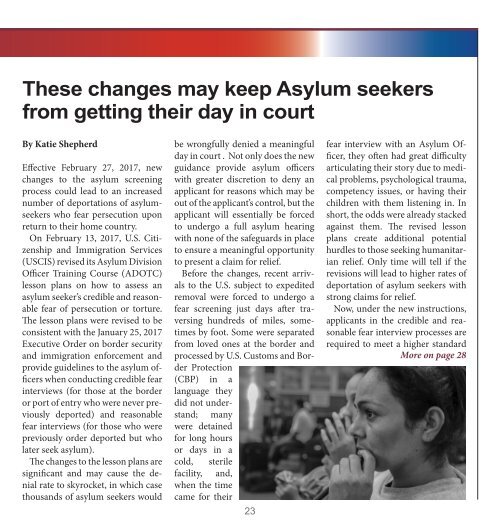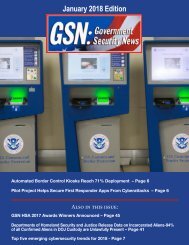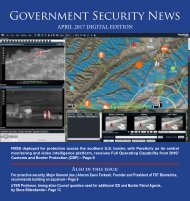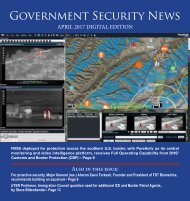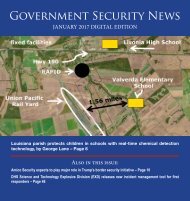GSN_Mar_YUMPU
Create successful ePaper yourself
Turn your PDF publications into a flip-book with our unique Google optimized e-Paper software.
These changes may keep Asylum seekers<br />
from getting their day in court<br />
By Katie Shepherd<br />
Effective February 27, 2017, new<br />
changes to the asylum screening<br />
process could lead to an increased<br />
number of deportations of asylumseekers<br />
who fear persecution upon<br />
return to their home country.<br />
On February 13, 2017, U.S. Citizenship<br />
and Immigration Services<br />
(USCIS) revised its Asylum Division<br />
Officer Training Course (ADOTC)<br />
lesson plans on how to assess an<br />
asylum seeker’s credible and reasonable<br />
fear of persecution or torture.<br />
The lesson plans were revised to be<br />
consistent with the January 25, 2017<br />
Executive Order on border security<br />
and immigration enforcement and<br />
provide guidelines to the asylum officers<br />
when conducting credible fear<br />
interviews (for those at the border<br />
or port of entry who were never previously<br />
deported) and reasonable<br />
fear interviews (for those who were<br />
previously order deported but who<br />
later seek asylum).<br />
The changes to the lesson plans are<br />
significant and may cause the denial<br />
rate to skyrocket, in which case<br />
thousands of asylum seekers would<br />
be wrongfully denied a meaningful<br />
day in court . Not only does the new<br />
guidance provide asylum officers<br />
with greater discretion to deny an<br />
applicant for reasons which may be<br />
out of the applicant’s control, but the<br />
applicant will essentially be forced<br />
to undergo a full asylum hearing<br />
with none of the safeguards in place<br />
to ensure a meaningful opportunity<br />
to present a claim for relief.<br />
Before the changes, recent arrivals<br />
to the U.S. subject to expedited<br />
removal were forced to undergo a<br />
fear screening just days after traversing<br />
hundreds of miles, sometimes<br />
by foot. Some were separated<br />
from loved ones at the border and<br />
processed by U.S. Customs and Border<br />
Protection<br />
(CBP) in a<br />
language they<br />
did not understand;<br />
many<br />
were detained<br />
for long hours<br />
or days in a<br />
cold, sterile<br />
facility, and,<br />
when the time<br />
came for their<br />
23<br />
fear interview with an Asylum Officer,<br />
they often had great difficulty<br />
articulating their story due to medical<br />
problems, psychological trauma,<br />
competency issues, or having their<br />
children with them listening in. In<br />
short, the odds were already stacked<br />
against them. The revised lesson<br />
plans create additional potential<br />
hurdles to those seeking humanitarian<br />
relief. Only time will tell if the<br />
revisions will lead to higher rates of<br />
deportation of asylum seekers with<br />
strong claims for relief.<br />
Now, under the new instructions,<br />
applicants in the credible and reasonable<br />
fear interview processes are<br />
required to meet a higher standard<br />
More on page 28


